Key takeaways:
- Burnout in programming can arise from unmanageable workloads, lack of autonomy, and feelings of isolation, impacting creativity and motivation.
- Recognizing signs of burnout, such as irritability and physical symptoms, is crucial for recovery and maintaining a healthy work-life balance.
- Implementing breaks, mindfulness practices, and community support are effective strategies for combating burnout and enhancing productivity.
- Utilizing tools like music players and terminal emulators within Linux can aid relaxation and help programmers recharge during intensive work sessions.
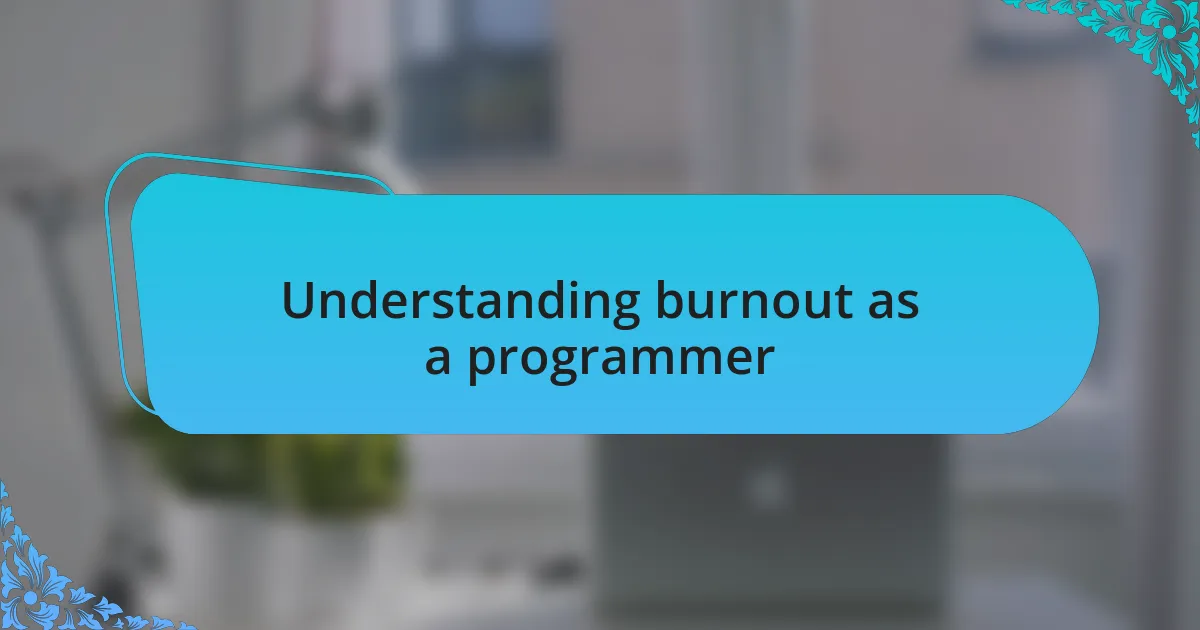
Understanding burnout as a programmer
Burnout, as a programmer, often creeps in when passion turns into obligation. I remember an intense period when I was juggling multiple projects, and the thrill of coding faded into a monotonous grind. It was then that I truly realized how the relentless demands of deadlines could sap my creativity and enthusiasm, leaving me feeling drained and unmotivated.
It’s fascinating to consider how the tech industry glorifies the “hustle” culture, where working longer hours is often seen as a badge of honor. Yet, from my experience, this only leads to a vicious cycle of overwork and diminishing returns. Have you ever found yourself staring at code, unable to focus, while your brain feels like a foggy mess? That’s a clear signal of burnout, one that I learned to recognize all too well.
Moreover, burnout isn’t just about the workload; it reflects a deeper emotional struggle. I once felt overwhelmed by the constant pressure to learn new technologies amidst my daily tasks. The anxiety of keeping up often clouded my ability to enjoy programming, stripping away the joy that originally drew me to this field. Engaging with my peers and sharing these feelings opened my eyes to how common this experience can be, reminding me that I’m not alone in this journey.
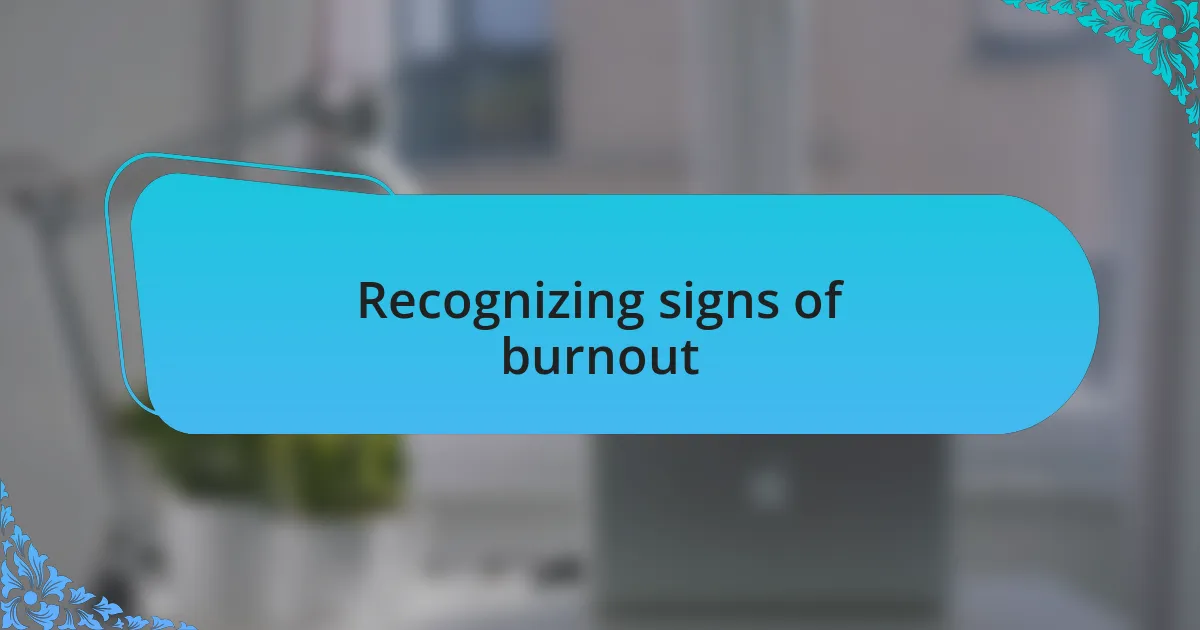
Recognizing signs of burnout
Recognizing the signs of burnout is often the first step toward recovery. I’ve found myself becoming increasingly irritable and impatient when small issues arise in projects that I used to handle effortlessly. Have you ever snapped at a teammate over a minor misunderstanding? That sudden frustration can be a telltale sign that your mental reserves are running low.
Another indicator I’ve observed is a noticeable decline in motivation to engage with coding, something that used to bring me pure joy. When I started viewing my daily tasks as just another obligation, the spark of inspiration faded. It’s unsettling to think about how easily we can disconnect from a passion that once ignited our enthusiasm.
Physical symptoms can also manifest when burnout sets in. I recall a phase when I constantly battled headaches and sleep disturbances, which I initially dismissed as stress. These bodily responses often serve as warning signs that our minds are overwhelmed, urging us to take a step back and reassess our work-life balance. How often do we overlook our bodies’ messages in the name of productivity?

Causes of burnout in programming
As I reflect on my journey as a programmer, I realize that one of the profound causes of burnout stems from unmanageable workloads. Have you ever looked at your to-do list and felt an immediate wave of dread wash over you? It’s impossible to maintain creativity and passion when the demands start piling up, leaving little room for reflection or innovation.
Another factor I’ve encountered is the lack of autonomy in projects. When my input feels disregarded and decisions are constantly imposed from above, it can lead to a sense of helplessness. I remember a situation where I was assigned to work on a feature that contradicted everything I believed was best for the project. That dissonance drained my energy and, quite frankly, my enthusiasm.
Isolation can also play a significant role in burnout. The digital nature of programming can leave us feeling disconnected from our peers. I once worked for weeks without meaningful interaction with my team. I felt like a ghost in the code—visible yet intangible. It’s a stark reminder of how important collaboration and camaraderie are; after all, aren’t we all in this together?
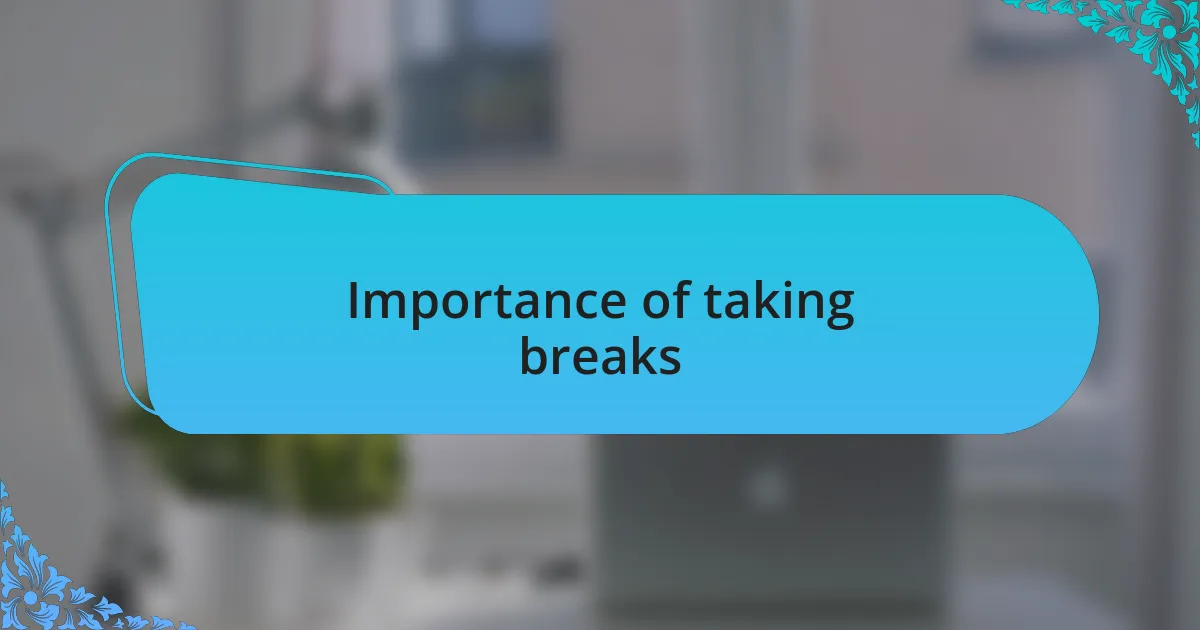
Importance of taking breaks
Taking breaks isn’t just a suggestion; it’s a necessity for anyone navigating the demanding world of programming. I remember a late-night coding session where I pushed through to fix a bug, but all I gained was frustration. After stepping away for just 15 minutes, I returned with a fresh perspective that led me to solve the issue in mere minutes. The simple act of stepping back can revive our focus and creativity, reminding us that our brains need a breather too.
When I incorporate breaks into my routine, I find they serve as a reset button. It’s fascinating how a walk outside or even just some time away from the screen can alleviate the tension built up from constant problem-solving. I often ask myself, how can I expect to be at my best if I’m not giving myself moments to recharge? Breaks offer just that—a chance to refuel and reconnect with my inner motivation.
Moreover, the impact of taking regular breaks extends beyond immediate relief; it fosters a healthy work culture. I’ve seen teams thrive when they embrace regular downtime. Team discussions over lunch or coffee breaks not only boost morale but also spark innovative ideas. Isn’t it incredible how something as simple as a pause can lead to breakthrough moments? Embracing this mindset has transformed the way I approach my work, turning what could feel overwhelming into a more manageable, enjoyable experience.
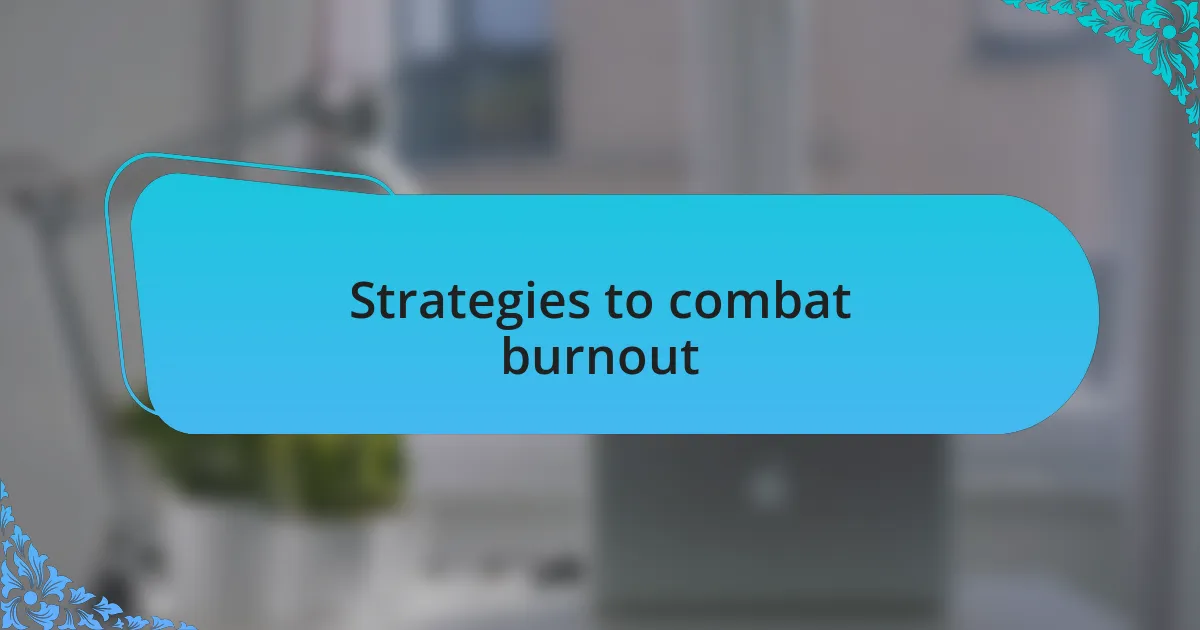
Strategies to combat burnout
Adopting a structured routine has been a game changer for me in managing burnout. I used to dive into my tasks without a clear plan, which often led to racing against the clock and feeling more overwhelmed. By setting specific goals for each day, I find that I can work through my priorities without losing sight of the bigger picture. Have you ever tried breaking your day into manageable chunks? It’s astonishing how far a little organization can go in easing stress.
Incorporating mindfulness practices has also helped me greatly. I vividly remember a time when I felt like code was racing through my mind. Taking a few moments to meditate or simply focus on my breathing has shifted my mental state entirely. It’s almost magical how a few minutes of mindfulness can ground me and improve my focus. Have you experienced that calming effect from simply pausing to breathe? I believe these brief moments can serve as vital checkpoints during our hectic days.
Lastly, seeking community support has proven invaluable. Early on in my career, I often felt isolated while troubleshooting complex issues. Connecting with fellow programmers through forums or local groups has shown me that sharing struggles not only lightens the burden but also leads to collaborative problem-solving. Have you ever found strength in camaraderie? I know that exchanging experiences with peers provides a sense of belonging and transforms burnout into shared resilience.
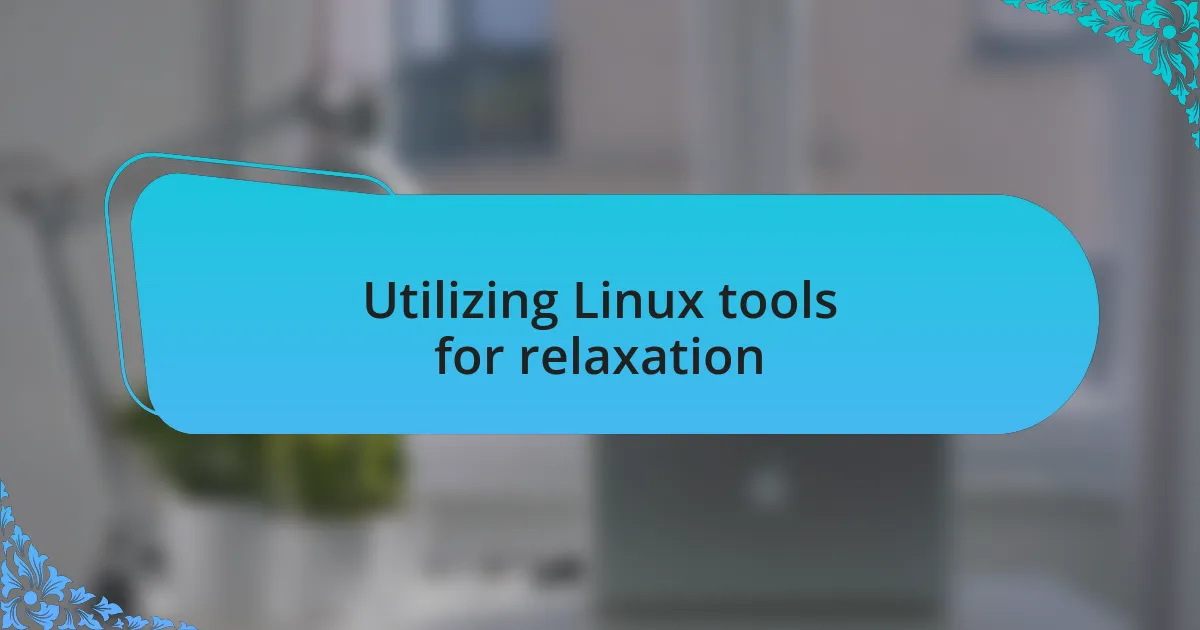
Utilizing Linux tools for relaxation
When I need a breather, I often turn to terminal-based music players like cmus or ncmpcpp. There’s something soothing about creating a customized playlist that helps clear my mind as I’m working with code. Have you ever noticed how music can change the atmosphere of your environment? I find that the right tracks can turn a stressful session into a more productive and relaxed experience.
Customization is another gift that Linux offers; I recently discovered the power of the feh image viewer to create calming background slideshows. Curating images from my past travels or joyful moments and letting them rotate on my desktop provides me a visual escape. It’s those little reminders of happiness that keep me grounded during long coding hours. Wouldn’t you agree that visual stimuli can help alleviate the stress of a busy day?
I’ve also started using terminal emulators like Terminator, which allows me to split the screen. This setup is perfect when I need to toggle between coding and my favorite text-based games for a short mental reset. Engaging in light gaming has proved beneficial; it helps me step away from the screen for a bit without straying too far from my work. Have you ever found that taking a brief, fun detour can actually bring your productivity back on track? It’s these simple Linux tools that, for me, transform downtime into refreshing moments of re-ignition.
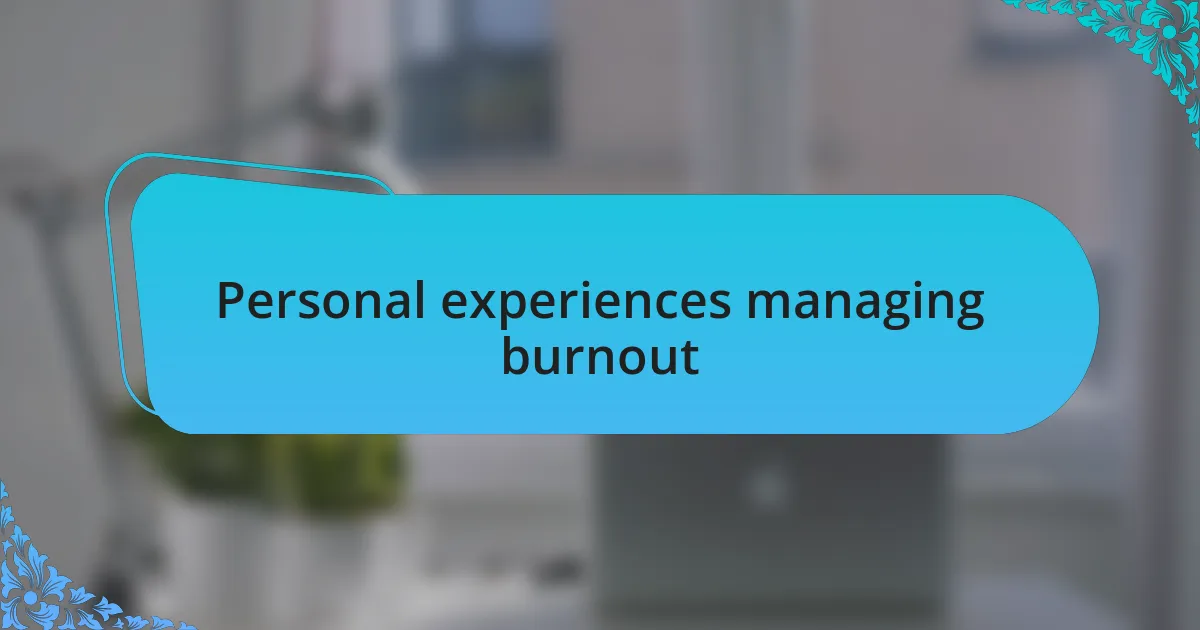
Personal experiences managing burnout
Balancing a heavy workload can often lead to feelings of overload. I remember a time when my codebase felt like a labyrinth, and I was continuously hitting dead ends. It was during this intense period that I learned to set small, achievable milestones. Breaking my tasks into bite-sized pieces not only made them less daunting but also allowed me to celebrate little victories, which lifted my spirits.
Another method I’ve embraced is the practice of stepping away from my desk entirely. On days when burnout loomed heavily, I’d take a short walk outside. The fresh air and change of scenery did wonders for my mindset, helping me to return to my computer with renewed energy. Have you ever noticed how simply stepping outside can shift your perspective? It’s fascinating how something so basic can recalibrate our thoughts.
I also find journaling to be a release. Whenever I feel the pressure mounting, I take a moment to jot down my thoughts. It’s a cathartic process that helps me articulate my frustrations and, more importantly, recognize patterns in my workload that contribute to stress. This simple act not only offers clarity but also reminds me that I’m not alone in this chaotic journey. Don’t you think reflecting on our challenges can be a crucial step towards finding effective solutions?